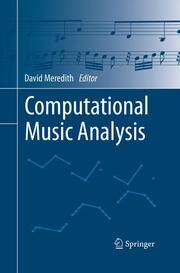Detailansicht
Computational Music Analysis
ISBN/EAN: 9783319387444
Umbreit-Nr.: 3465403
Sprache:
Englisch
Umfang: xv, 480 S.
Format in cm:
Einband:
kartoniertes Buch
Erschienen am 23.08.2016
Auflage: 1/2016
- Zusatztext
- This book provides an in-depth introduction and overview of current research in computational music analysis. Its seventeen chapters, written by leading researchers, collectively represent the diversity as well as the technical and philosophical sophistication of the work being done today in this intensely interdisciplinary field. A broad range of approaches are presented, employing techniques originating in disciplines such as linguistics, information theory, information retrieval, pattern recognition, machine learning, topology, algebra and signal processing. Many of the methods described draw on well-established theories in music theory and analysis, such as Forte's pitch-class set theory, Schenkerian analysis, the methods of semiotic analysis developed by Ruwet and Nattiez, and Lerdahl and Jackendoff's Generative Theory of Tonal Music. The book is divided into six parts, covering methodological issues, harmonic and pitch-class set analysis, form and voice-separation, grammars and hierarchical reduction, motivic analysis and pattern discovery and, finally, classification and the discovery of distinctive patterns. As a detailed and up-to-date picture of current research in computational music analysis, the book provides an invaluable resource for researchers, teachers and students in music theory and analysis, computer science, music information retrieval and related disciplines. It also provides a state-of-the-art reference for practitioners in the music technology industry.
- Kurztext
- This book provides an in-depth introduction and overview of current research in computational music analysis. Its seventeen chapters, written by leading researchers, collectively represent the diversity as well as the technical and philosophical sophistication of the work being done today in this intensely interdisciplinary field. A broad range of approaches are presented, employing techniques originating in disciplines such as linguistics, information theory, information retrieval, pattern recognition, machine learning, topology, algebra and signal processing. Many of the methods described draw on well-established theories in music theory and analysis, such as Forte's pitch-class set theory, Schenkerian analysis, the methods of semiotic analysis developed by Ruwet and Nattiez, and Lerdahl and Jackendoff's Generative Theory of Tonal Music. The book is divided into six parts, covering methodological issues, harmonic and pitch-class set analysis, form and voice-separation, grammars and hierarchical reduction, motivic analysis and pattern discovery and, finally, classification and the discovery of distinctive patterns. As a detailed and up-to-date picture of current research in computational music analysis, the book provides an invaluable resource for researchers, teachers and students in music theory and analysis, computer science, music information retrieval and related disciplines. It also provides a state-of-the-art reference for practitioners in the music technology industry.
- Autorenportrait
- David Meredith is an Associate Professor in the Dept. of Architecture, Design and Media Technology at Aalborg University. He has Bachelor's and Master's degrees in natural sciences and music from the University of Cambridge and a D.Phil. from the Faculty of Music of the University of Oxford. His research focuses on algorithms for analysing musical structure. He developed the first practical algorithms for discovering repeated patterns in polyphonic music and the most accurate pitch spelling algorithm to date. He is the lead investigator at Aalborg University on the EU collaborative project, "Learning to Create" (Lrn2Cre8).
